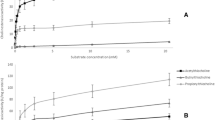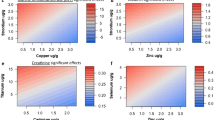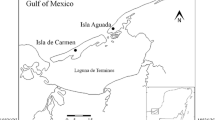Abstract
Studies are increasingly using cholinergic parameters as biomarkers of early neurotoxicity, but few have characterized this system in ecologically relevant model organisms. In the present study, key neurochemicals in the cholinergic pathway were measured and analyzed from discrete parts of brain and blood from captive mink (Mustela vison). Similar to other mammals, the regional distribution of cholinergic parameters in the brain could be ranked from highest to lowest as: basal ganglia > occipital cortex > brain stem > cerebellum (F 3,192 = 172.1, p < 0.001). Higher variation in cholinergic parameters was found in the cerebellum (coefficient of variation = 34.9%), and the least variation was measured in the brain stem (19.7%). Variation was also assessed by calculating the difference between the lowest and highest measures among individual animals: choline acetyltransferase (1.6× fold difference), cholinesterase (2.0×), muscarinic receptor levels (2.4×), acetylcholine (3.7×), nicotinic receptor levels (3.9×), and choline transporter (5.0×). In blood samples, activity and inter-individual variation of cholinesterase was highest in whole blood and lowest in plasma and serum. By using captive mink of a common genetic source, age, gender, and rearing conditions, these data help establish normal levels, ranges, and variations of cholinergic biomarkers among brain regions, blood components, and individual animals. Such information may better enable the utility of cholinergic biomarkers in environmental assessments.
Similar content being viewed by others
References
Abou-Donia, M. B. (2003). Organophosphorus ester-induced chronic neurotoxicity. Archives of Environmental Health, 58, 484–497. doi:10.3200/AEOH.58.8.484-497.
Basu, N., Klenavic, K., Gamberg, M., O’Brien, M., Evans, R. D., Scheuhammer, A. M., et al. (2005a). Effects of mercury on neurochemical receptor binding characteristics in wild mink. Environmental Toxicology and Chemistry, 24, 1444–1450. doi:10.1897/04-048R.1.
Basu, N., Kwan, M., & Chan, H. M. (2006a). Mercury but not organochlorines inhibit muscarinic cholinergic receptor binding in the cerebrum of ringed seals (Phoca hispida). Journal of Toxicology and Environmental Health, 69, 1133–1143. doi:10.1080/15287390500362394.
Basu, N., Scheuhammer, A. M., Bursian, S. J., Elliott, J., Rouvinen-Watt, K., & Chan, H. M. (2007). Mink as a sentinel in environmental health. Environmental Research, 103, 130–144. doi:10.1016/j.envres.2006.04.005.
Basu, N., Scheuhammer, A. M., Grochowina, N., Klenavic, K., Evans, D., O’Brien, M., et al. (2005b). Effects of mercury on neurochemical receptors in wild river otters (Lontra canadensis). Environmental Science & Technology, 39, 3585–3591. doi:10.1021/es0483746.
Basu, N., Scheuhammer, A. M., Rouvinen-Watt, K., Grochowina, N., Klenavic, K., Evans, R. D., et al. (2006b). Methylmercury impairs components of the cholinergic system in captive mink (Mustela vison). Toxicological Sciences, 91, 202–209. doi:10.1093/toxsci/kfj121.
Bradford, M. M. (1976). A rapid and sensitive method for the quantification of microgram quantities of protein utilizing the principle of protein-dye binding. Analytical Biochemistry, 72, 248–254. doi:10.1016/0003-2697(76)90527-3.
Coccini, T., Randine, G., Candura, S. M., Nappi, R. E., Prockop, L. D., & Manzo, L. (2000). Low-level exposure to methylmercury modifies muscarinic cholinergic receptor binding characteristics in rat brain and lymphocytes: Physiologic implications and new opportunities in biologic monitoring. Environmental Health Perspectives, 108, 29–33. doi:10.2307/3454292.
Coccini, T., Randine, G., Castoldi, A. F., Grandjean, P., Ostendorp, G., Heinzow, B., et al. (2006). Effects of developmental co-exposure to methylmercury and 2,2′,4,4′,5,5′-hexachlorobiphenyl (PCB153) on cholinergic muscarinic receptors in rat brain. Neurotoxicology, 27, 468–477. doi:10.1016/j.neuro.2005.12.004.
Dajas-Bailador, F., & Wonnacott, S. (2004). Nicotinic acetylcholine receptors and the regulation of neuronal signalling. Trends in Pharmacological Sciences, 25, 317–324. doi:10.1016/j.tips.2004.04.006.
Dietl, M. M., Cortés, R., & Palacios, J. M. (1988). Neurotransmitter receptors in the avian brain. II. Muscarinic cholinergic receptors. Brain Research, 439, 360–365.
Fonnum, F. (1975). A rapid radiochemical method for the determination of choline acetyltransferase. Journal of Neurochemistry, 24, 407–409. doi:10.1111/j.1471-4159.1975.tb11895.x.
Goldberg, A. M., & Hanin, I. (1976). Biology of cholinergic function. New York: Raven.
Gupta, R. (2004). Brain regional heterogeneity and toxicological mechanisms of organophosphates and carbamates. Toxicology Mechanisms and Methods, 14, 103–143. doi:10.1080/15376520490429175.
Gupta, R. C., Patterson, G. T., & Dettbarn, W. D. (1991). Comparison of cholinergic and neuromuscular toxicity following acute exposure to sarin and VX in rat. Fundamental and Applied Toxicology, 16, 449–458. doi:10.1016/0272-0590(91)90085-I.
Jett, D. A., Hill, E. F., Fernando, J. C., Eldefrawi, M. E., & Eldefrawi, A. T. (1993). Down-regulation of muscarinic receptors and the m3 subtype in white-footed mice by dietary exposure to parathion. Journal of Toxicology and Environmental Health, 39, 395–415
Jones, S. B., King, L. B., Sappington, L. C., Dwyer, F. J., Ellersieck, M., & Buckler, D. R. (1998). Effects of carbaryl, permethrin, 4-nonylphenol, and copper on muscarinic cholinergic receptors in brain of surrogate and listed fish species. Comparative Biochemistry and Physiology, 120(Pt C), 405–414.
McGehee, D. S., & Role, L. W. (1995). Physiological diversity of nicotinic acetylcholine receptors expressed by vertebrate neurons. Annual Review of Physiology, 57, 521–546. doi:10.1146/annurev.ph.57.030195.002513.
McQueen, M. J. (1995). Clinical and analytical considerations in the utilization of cholinesterase measurements. Clinica Chimica Acta, 237, 91–105. doi:10.1016/0009-8981(95)06067-N.
Mineau, P. (1991). Cholinesterase-inhibiting insecticides. Amsterdam: Elsevier Science.
Oda, Y. (1999). Choline acetyltransferase: The structure, distribution and pathologic changes in the central nervous system. Pathology International, 49, 921–937. doi:10.1046/j.1440-1827.1999.00977.x.
Okudza, T., & Haga, T. (2003). High-affinity choline transporter. Neurochemical Research, 28, 483–488. doi:10.1023/A:1022809003997.
Rozengart, E. V., Khovanskikh, A. E., Basoval, N. E., Moralev, S. N. (2003). Comparative enzymologic study of catalytic properties of blood serum cholinesterase of the American mink Mustela vison. Journal of Evolutionary Biochemistry and Physiology, 38, 401–406. doi:10.1023/A:1021145602100.
Salvaterra, P. M., Mahler, H. R., & Moore, W. J. (1975). Subcellular and regional distribution of 125I-labeled alpha-bungarotoxin binding in rat brain and its relationship to acetylcholinesterase and choline acetyltransferase. The Journal of Biological Chemistry, 250, 6469–6475.
Silman, I., & Sussman, J. L. (2005). Acetylcholinesterase: ‘Classical’ and ‘non-classical’ functions and pharmacology. Current Opinion in Pharmacology, 5, 293–302. doi:10.1016/j.coph.2005.01.014.
Stavinoha, W. B., Weintraub, S. T., & Modak, A. T. (1973). The use of microwave heating to inactivate cholinesterase in the rat brain prior to analysis for acetylcholine. Journal of Neurochemistry, 20, 361–371. doi:10.1111/j.1471-4159.1973.tb12135.x.
Szabó, A., Nencsók, J., Kása, P., & Gulya, K. (1989). Muscarinic cholinergic components in carp brain. Neurochemistry International, 15, 511–516. doi:10.1016/0197-0186(89)90171-X.
Trauth, J. A., Seidler, F. J., McCook, E. C., & Slotkin, T. A. (1999). Adolescent nicotine exposure causes persistent upregulation of nicotinic cholinergic receptors in rat brain regions. Brain Research, 851, 9–19. doi:10.1016/S0006-8993(99)01994-0.
Venter, J. C., Eddy, B., Hall, L. M., & Fraser, C. M. (1984). Monoclonal antibodies detect the conservation of muscarinic cholinergic receptor structure from Drosophila to human brain and detect possible structural homology with alpha 1-adrenergic receptors. Proceedings of the National Academy of Sciences of the United States of America, 81, 272–276. doi:10.1073/pnas.81.1.272.
Vickroy, T., Roeske, W., & Yamamura, H. (1984). Sodium-dependent high-affinity binding of [3H]hemicholinium-3 in the rat brain: A potentially selective marker for presynaptic cholinergic sites. Life Sciences, 35, 2335–2343. doi:10.1016/0024-3205(84)90525-3.
Wess, J. (1996). Molecular biology of muscarinic acetylcholine receptors. Critical Reviews in Neurobiology, 10, 69–99.
Wess, J. (2004). Muscarinic acetylcholine receptor knockout mice: Novel phenotypes and clinical implications. Annual Review of Pharmacology and Toxicology, 44, 423–450. doi:10.1146/annurev.pharmtox.44.101802.121622.
Wessler, I., Kirkpatrick, C. J., & Racke, K. (1999). The cholinergic ‘pitfall’: Acetylcholine, a universal cell molecule in biological systems, including humans. Clinical and Experimental Pharmacology & Physiology, 26, 198–205. doi:10.1046/j.1440-1681.1999.03016.x.
Yamamura, H. I., & Snyder, S. H. (1974). Muscarinic cholinergic binding in rat brain. Proceedings of the National Academy of Sciences of the United States of America, 71, 1725–1729. doi:10.1073/pnas.71.5.1725.
Zanoli, P., Truzzi, C., Veneri, C., Braghiroli, D., & Baraldi, M. (1994). Methyl mercury during late gestation affects temporarily the development of cortical muscarinic receptors in rat offspring. Pharmacology & Toxicology, 75, 261–264.
Author information
Authors and Affiliations
Corresponding author
Rights and permissions
About this article
Cite this article
Basu, N., Scheuhammer, A., Rouvinen-Watt, K. et al. Variation of cholinergic biomarkers in brain regions and blood components of captive mink. Environ Monit Assess 162, 377–386 (2010). https://doi.org/10.1007/s10661-009-0803-2
Received:
Accepted:
Published:
Issue Date:
DOI: https://doi.org/10.1007/s10661-009-0803-2




